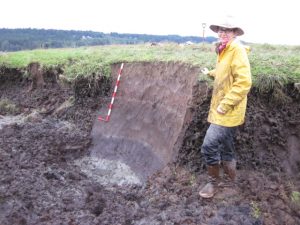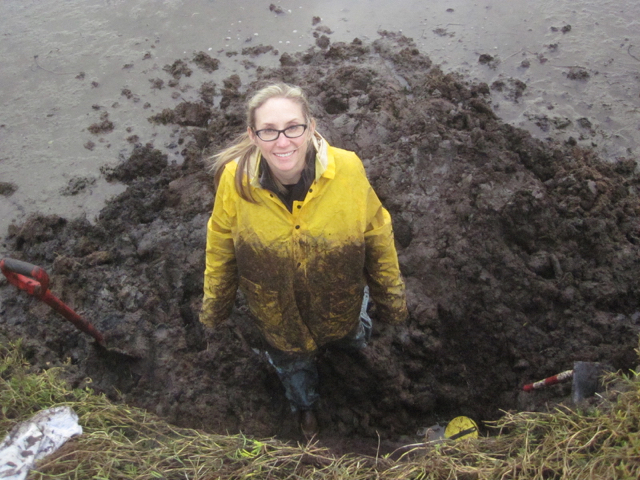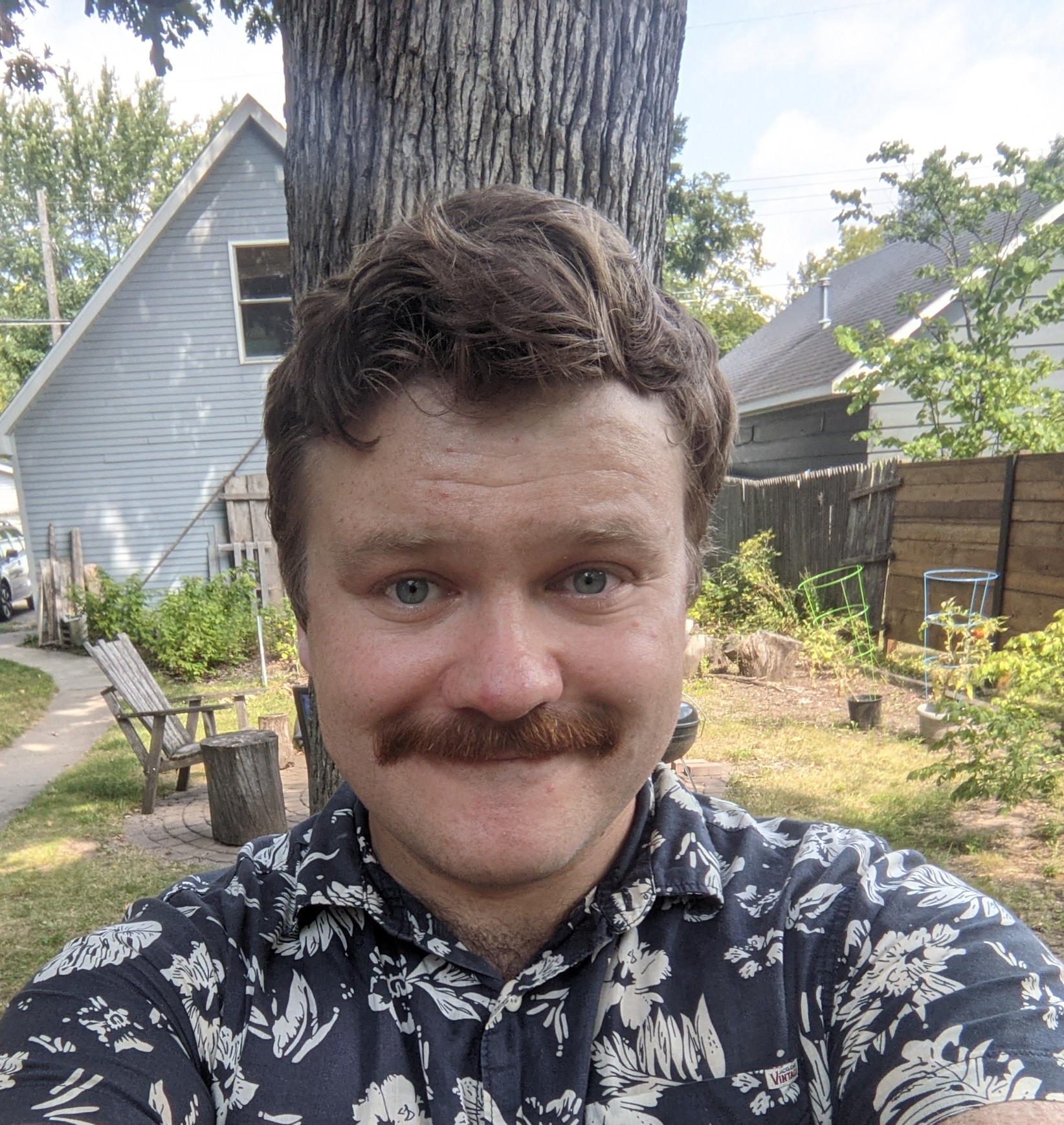 Abstract: My research seeks to determine where Cascadia tsunamis been recorded in Puget Sound tidal marshes; and what environmental changes, if any, occurred in these tidal marshes in response to coseismic and/or postseismic deformation from great earthquakes on the Cascadia Subduction Zone.
Abstract: My research seeks to determine where Cascadia tsunamis been recorded in Puget Sound tidal marshes; and what environmental changes, if any, occurred in these tidal marshes in response to coseismic and/or postseismic deformation from great earthquakes on the Cascadia Subduction Zone.
The extent that Cascadia earthquakes and tsunamis affect Puget Sound is relatively unknown. I will use diatom paleoecology and sedimentology to study two types of evidence. First, I will identify tsunami deposits preserved in Puget Sound tidal marshes. Second, I will determine whether or not Puget Sound tidal marshes record land-level change that coincided with, or shortly followed, great Cascadia earthquakes.
Report: During the summer of 2015, I continued my study of Puget Sound tidal marshes for evidence of seismic hazards from the Cascadia subduction zone. I focused on the record of tsunami deposits in Puget Sound that I hypothesize are from the subduction zone.
I worked at sites in Hood Canal (Lynch Cove), Discovery Bay, and Port Townsend Bay. I refined the dating for tsunami deposits from Lynch Cove and Discovery Bay by collecting and submitting additional radiocarbon samples, and these new dates have narrowed the timing of the tsunami events at both sites. In particular, the ages of the tsunami deposits at Discovery Bay are poorly constrained, so narrowing the age ranges helps with comparisons to the record at Lynch Cove, evidence for subduction zone earthquakes from the outer coast of Washington, and other future sites with tsunami deposits.
At both Lynch Cove and Discovery Bay, I also worked with personnel from the Washington Department of Natural Resources, refining the use of Ground Penetrating Radar in order to trace the tsunami deposits in the subsurface. The method was successful, and the findings were presented at the fall American Geophysical Union (AGU) meeting in December 2015. I was a coauthor on the presentation.
 Other fieldwork completed included describing potential new tsunami deposits at Port Townsend Bay. I used recent tsunami simulations that predict high water “hot spots” for several sites in Puget Sound to search for historically undisturbed marsh sites that may preserve tsunami deposits. I explored several promising marshes without finding sand layers, but I did find two sand layers that are likely tsunami deposits in a marsh at the south end of Port Townsend Bay. I have radiocarbon samples from these layers awaiting dating with expected USGS funding.
Other fieldwork completed included describing potential new tsunami deposits at Port Townsend Bay. I used recent tsunami simulations that predict high water “hot spots” for several sites in Puget Sound to search for historically undisturbed marsh sites that may preserve tsunami deposits. I explored several promising marshes without finding sand layers, but I did find two sand layers that are likely tsunami deposits in a marsh at the south end of Port Townsend Bay. I have radiocarbon samples from these layers awaiting dating with expected USGS funding.
I collected new modern diatom samples to add to the regional modern diatom database that will be used for sea level reconstruction at Lynch Cove in early 2016. I purchased a salinity meter with funds received from the QRC to help with characterizing these modern samples. I used modern and fossil diatoms to confirm that the tide flat next to the marsh at Lynch Cove is the likely source of the sediments in the tsunami deposits at Lynch Cove.
I forged a new collaborative relationship with professors Randy LeVeque and Loyce Adams, Department of Applied Mathematics, University of Washington. They developed GeoClaw software to model tsunami simulations, and they created new simulations of the Hood Canal area that show water heights of 5+ meters at Lynch Cove for a Cascadia tsunami. In addition, they have agreed to train me to use GeoClaw, so I can learn to model other sites to complement my tsunami hazard research.
I traveled to San Francisco and presented my Lynch Cove tsunami research findings at the annual AGU meeting on Dec 15th. My work was well-received, and my talk resulted in multiple discussions with out of state and international workers, as well as invitations to collaborate with others doing complementary work.
 Abstract: The effects of tsunamis are not isolated to the destructive force of the wave alone. This is apparent in the interactions between the saline seawater of a tsunami and freshwater stored in groundwater-bearing geologic formations known as aquifers. Research suggests that tsunami-related salinization may yield groundwater undrinkable for 4 to 15 years following a tsunami. Key variables of uncertainty are tsunami inundation height, rainfall recharge rate, and the speed at which water can pass through site-specific geologic material. Thus, studying this problem is interdisciplinary and requires methodologies from both the coastal hazards and hydrogeological disciplines. In North America, the area with the highest tsunami risk is the Cascadia Subduction Zone (CSZ) – an area of tectonism from northern California to southern British Columbia. The most recent tsunami and subsequent tsunami deposit in the CSZ (a thin < 5 cm layer of sand contained within marsh sediments) is from the 1964 Alaska earthquake/tsunami which caused damage to the coastal communities of Port Alberni, Ucluelet, and Tofino, BC. I will develop a methodology seeking to answer two questions: (1) can grain size distributions of the 1964 tsunami deposit be used to reconstruct the 1964 tsunami wave height and from this data, can a map of the geographic extent of the tsunami be generated? 2. Based on (1) and considering variations in precipitation and aquifer materials, what is the vulnerability of regional groundwater to future tsunamis? I will generate a groundwater vulnerability map for the region. This will be the first map of its kind created in Canada and provide not only vital information for communities in the region seeking to protect their water supply but also act as a blueprint for future studies.
Abstract: The effects of tsunamis are not isolated to the destructive force of the wave alone. This is apparent in the interactions between the saline seawater of a tsunami and freshwater stored in groundwater-bearing geologic formations known as aquifers. Research suggests that tsunami-related salinization may yield groundwater undrinkable for 4 to 15 years following a tsunami. Key variables of uncertainty are tsunami inundation height, rainfall recharge rate, and the speed at which water can pass through site-specific geologic material. Thus, studying this problem is interdisciplinary and requires methodologies from both the coastal hazards and hydrogeological disciplines. In North America, the area with the highest tsunami risk is the Cascadia Subduction Zone (CSZ) – an area of tectonism from northern California to southern British Columbia. The most recent tsunami and subsequent tsunami deposit in the CSZ (a thin < 5 cm layer of sand contained within marsh sediments) is from the 1964 Alaska earthquake/tsunami which caused damage to the coastal communities of Port Alberni, Ucluelet, and Tofino, BC. I will develop a methodology seeking to answer two questions: (1) can grain size distributions of the 1964 tsunami deposit be used to reconstruct the 1964 tsunami wave height and from this data, can a map of the geographic extent of the tsunami be generated? 2. Based on (1) and considering variations in precipitation and aquifer materials, what is the vulnerability of regional groundwater to future tsunamis? I will generate a groundwater vulnerability map for the region. This will be the first map of its kind created in Canada and provide not only vital information for communities in the region seeking to protect their water supply but also act as a blueprint for future studies. Abstract: Geologic records of past Cascadia earthquakes and tsunamis from Washington, Oregon, and northern California record up to the last ~4,500 years of repeated earthquakes and tsunamis. This information has informed rupture models and improved risk assessment for the Cascadia coastline. However, long-term records of earthquakes and tsunamis in northern Cascadia (i.e., southern British Columbia) are not as common and rarely predate the most recent 1700 event, hindering a complete understanding of the entire subduction zone. To address this knowledge gap, this project aims to reconstruct the longest onshore record of tsunamis in northern Cascadia. Salt marsh sediments in Port Alberni (Vancouver Island) will be investigated using a multi-proxy approach (i.e., stratigraphy, micropaleontology, elemental geochemistry, and sediment grain size) to document a series of previously reported and newly discovered units that are inferred to be from past tsunamis spanning at least the last ~5,000 years. The Quaternary Research Centre has provided funding for radiocarbon dating to constrain the age of each event. These dates will be used to create a robust Bayesian age-depth model permitting the correlation of events between Port Alberni and further afield locations in Washington State (e.g., Discovery Bay). Correlations between sites in middle and northern Cascadia will tease out local and distant sources for earthquakes and tsunamis, providing insight to the magnitude and frequency patterns of past events. Not only is a record from northern Cascadia critical in assessing seismic hazards in Canada, it will also elucidate subduction zone characteristics that have implications for the entire Cascadia coastline.
Abstract: Geologic records of past Cascadia earthquakes and tsunamis from Washington, Oregon, and northern California record up to the last ~4,500 years of repeated earthquakes and tsunamis. This information has informed rupture models and improved risk assessment for the Cascadia coastline. However, long-term records of earthquakes and tsunamis in northern Cascadia (i.e., southern British Columbia) are not as common and rarely predate the most recent 1700 event, hindering a complete understanding of the entire subduction zone. To address this knowledge gap, this project aims to reconstruct the longest onshore record of tsunamis in northern Cascadia. Salt marsh sediments in Port Alberni (Vancouver Island) will be investigated using a multi-proxy approach (i.e., stratigraphy, micropaleontology, elemental geochemistry, and sediment grain size) to document a series of previously reported and newly discovered units that are inferred to be from past tsunamis spanning at least the last ~5,000 years. The Quaternary Research Centre has provided funding for radiocarbon dating to constrain the age of each event. These dates will be used to create a robust Bayesian age-depth model permitting the correlation of events between Port Alberni and further afield locations in Washington State (e.g., Discovery Bay). Correlations between sites in middle and northern Cascadia will tease out local and distant sources for earthquakes and tsunamis, providing insight to the magnitude and frequency patterns of past events. Not only is a record from northern Cascadia critical in assessing seismic hazards in Canada, it will also elucidate subduction zone characteristics that have implications for the entire Cascadia coastline.
 Other fieldwork completed included describing potential new tsunami deposits at Port Townsend Bay. I used recent tsunami simulations that predict high water “hot spots” for several sites in Puget Sound to search for historically undisturbed marsh sites that may preserve tsunami deposits. I explored several promising marshes without finding sand layers, but I did find two sand layers that are likely tsunami deposits in a marsh at the south end of Port Townsend Bay. I have radiocarbon samples from these layers awaiting dating with expected USGS funding.
Other fieldwork completed included describing potential new tsunami deposits at Port Townsend Bay. I used recent tsunami simulations that predict high water “hot spots” for several sites in Puget Sound to search for historically undisturbed marsh sites that may preserve tsunami deposits. I explored several promising marshes without finding sand layers, but I did find two sand layers that are likely tsunami deposits in a marsh at the south end of Port Townsend Bay. I have radiocarbon samples from these layers awaiting dating with expected USGS funding.